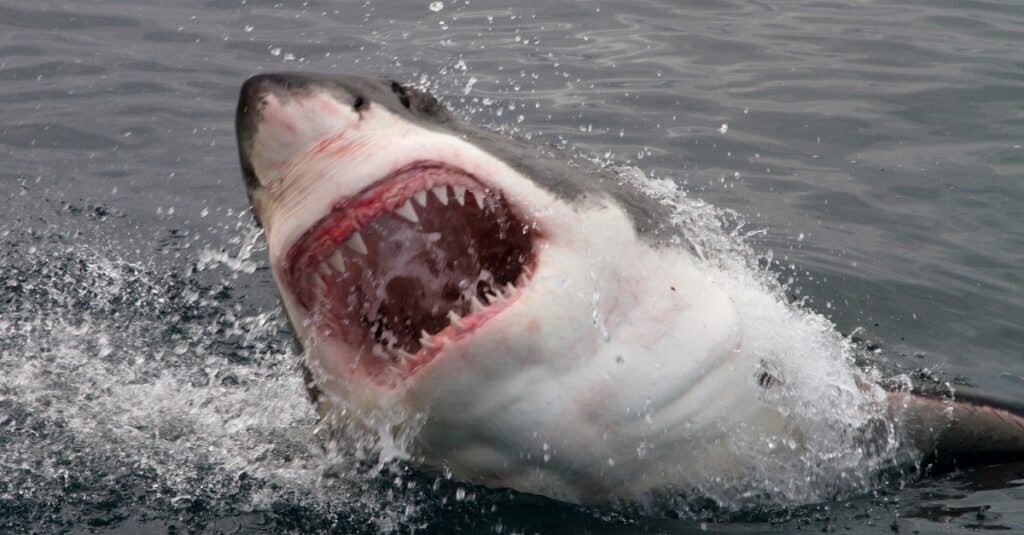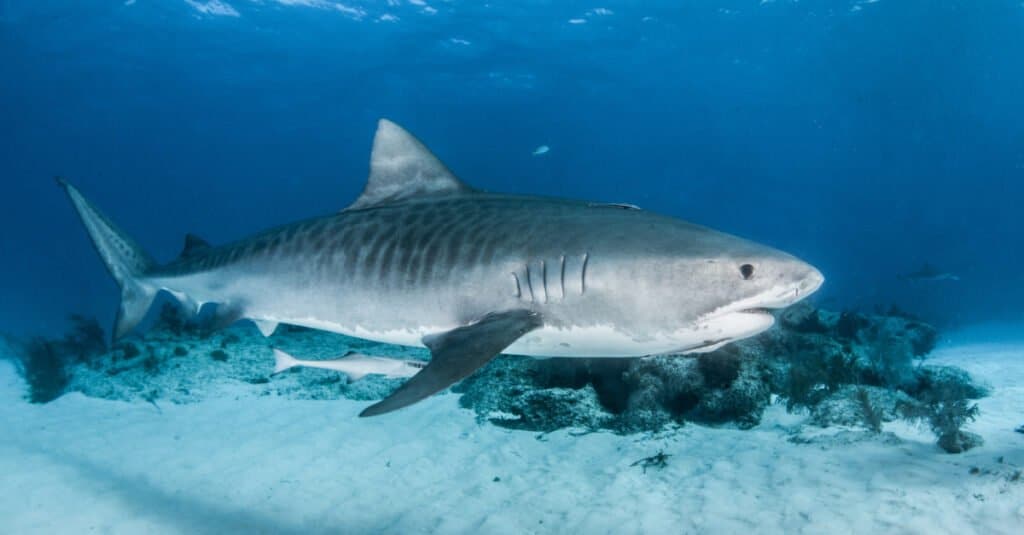Key Points:
- Sharks belong to the class Chondrichthyes of cartilaginous fish. As they have a skeleton made from cartilage rather than bone, sharks don’t have a single bone in their bodies!
- Different parts of sharks’ bodies are made from varying strengths of cartilage, such as their heads being made from calcified cartilage to protect their brains.
- A cartilaginous skeleton gives sharks more flexibility, helping them swim fast and make quick turns when chasing prey, and allowing them to open their mouths wide and exert a greater bite force.
Sharks are some of the most notorious and feared predators in the world, found in every ocean and some rivers. They’re often known as “living fossils” as they have roamed the oceans for more than 400 million years, meaning they were even around before the dinosaurs. However, despite how long they’ve been around there’s still more to learn about them. There’s one question that often comes up when we’re discussing sharks, and that is whether they have bones or not.
So do sharks have bones? Surely creatures as powerful and ferocious as they are would have bones, wouldn’t they? Find out the answer below!
Do Sharks Actually Have Bones?
Many animals have a skeleton that is made from bone and it gives their body shape and gives them strength. So, considering that sharks are one of the most powerful predators in the ocean and have an incredible bite force, it would be easy to assume that they must have tough bones. However, sharks are from the class Chondrichthyes which means “cartilage fish”, as opposed to Osteichthyes which are bony fish. They are also from the subclass Elasmobranchii which includes all sharks, rays, skates, and sawfish. As sharks are cartilaginous fish they have a skeleton that is made from cartilage rather than bone. In fact, a shark doesn’t even have a single shark bone in its body!
Cartilage is a tissue that is softer and more flexible than bone. However, even though sharks have a cartilaginous skeleton it is still tough and does exactly the same job that a skeleton made from bone does. It gives their bodies shape and structure and protects their organs.
Different parts of their bodies are made from different strengths of cartilage and some areas are more flexible than others. Areas that need more protection are made from calcified cartilage which has been calcified by calcium salts and which makes it much, much tougher. So sharks heads are made from calcified cartilage so that their brain is protected. Parts of their jaw are also made from calcified cartilage (such as their jaw bone) while other parts (such as their snout) are made from softer cartilage. This allows the shark to have the benefit of a tougher skeleton in the areas that they need it most, while still taking advantage of all of the other benefits that come from having a cartilaginous skeleton as well.
What Are the Advantages of a Cartilaginous Skeleton?

Having a flexible skeleton allows sharks to open their mouth further and exert a greater bite force.
©iStock.com/Peter_Nile
Having a skeleton that is made from cartilage rather than bone is actually a great advantage to sharks and is one of the reasons that they are such capable and powerful predators. Cartilage is much lighter than bone which is important because sharks don’t have a swim bladder. Instead, they have to rely on their large oil-filled liver to provide them with buoyancy. Therefore, a really heavy skeleton would be a major disadvantage to them. Also, as cartilage is much more flexible than bone it also allows sharks to swim fast and make quick turns when they’re chasing prey.
Another advantage of having a cartilaginous skeleton is that it allows the shark’s jaw to be much more flexible. This means that they are able to open their mouths much wider than they would if they had a jaw made from bone. As they can open their mouths wider they are able to exert much more downward force in their bite. This is why sharks have some of the greatest bite forces around and makes them some of the most savage predators in the ocean. However, sharks’ snouts are made from particularly soft and flexible cartilage. This means that their snout can act like a bumper and can absorb heavy blows without suffering much damage.
How Are Sharks Vertebrates Then?
Sharks are classed as vertebrates, which means that they have a backbone. But how can they have a backbone if they don’t have bones? The truth is that an animal doesn’t have to have a backbone made from bone to be a vertebrate. Sharks have a spinal column that is made from cartilage just like the rest of their skeleton. It protects their spinal cord exactly the same way that one made from bone does. This is because the cartilage that makes up the spinal column of the shark is calcified. As the cartilage is calcified it is tough enough to provide the necessary protection to the spinal cord.

Even though sharks don’t have bones they are still vertebrates as they have a backbone made from cartilage.
©iStock.com/Divepic
Did Ancient Sharks Have Bones?
As we’ve already mentioned, sharks have been around for a really long time, and in that time they’ve evolved a great deal. But what if you traveled back in time and asked “Do sharks have bones?” what discoveries would you unearth? Did prehistoric sharks also have cartilaginous skeletons, or did they actually have bones?
The key to discovering the answer is to look at the fossil record. The earliest fossil record of sharks is a few scales that date back to 450 million years ago. Then there’s some shark teeth from 410 million years ago. In fact, all the way through the fossil record it’s only shark teeth, dermal denticles, and vertebral centra (dorsal fins) — no bones. Therefore, as there are no fossilized shark bones found it’s pretty safe to say that all sharks — and even their earliest ancestors — have had cartilaginous skeletons rather than bones.
Cartilage doesn’t fossilize well because it is much softer than bone and breaks down quickly. However, some cartilage (such as parts of the jaw, vertebrae, and dorsal fin) are calcified, which makes them much tougher. As this cartilage is much harder it can be fossilized, although it is still found only very rarely.
Shark teeth are the part of sharks that are most commonly fossilized. Aside from it being because they are literally the hardest part of a shark (made of dentin, which is tougher than bone), it is also because there are so many of them. Sharks typically just replace lost or worn down teeth — the old only drop out and new ones take their place. This means that vast, vast numbers of shark teeth have dropped to the ocean floor over millions of years. This greatly increases the chance of them ending up fossilized compared with the dermal denticles and dorsal fins.
The photo featured at the top of this post is © iStock.com/mirror-images
Thank you for reading! Have some feedback for us? Contact the AZ Animals editorial team.






